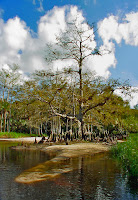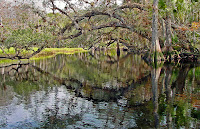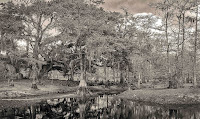A little history about Fisheating Creek
Fisheating Creek is a State of Florida Wildlife Management Area, that meanders for 40 miles through a wildlife-rich area, long valved for its scenic "Old Florida" beauty. The name "Fisheating Creek" is derived from the Creek Thlothlopopka-hatchee Indians meaning,
"The Creek where Fish are Eaten". The first know settlements were located along the banks of Fisheating Creek between 1000 and 500 BC. The early inhabitants known as the Belle Glade People, began building mounds and other earthworks and sustained by eating fish and harvesting turtles, snakes, and alligators. The creek was more than a source of food and water, as it was also a canoe highway leading west to Lake Okeechobee and its resources to the East and other settlements to the West.
Much of the land surrounding the creek came to be owned by the Lykes Brothers. The Lykes Empire began in the 1880s when Dr. Howell Tyson Lykes began exporting cattle to Cuba. All seven of his sons went into the family cattle and shipping business. Today Lykes Brothers Inc. is the largest producer of cattle and the largest meat packer in Florida.

Over the years the creek has been the focal point in the lives of the local people. They courted, married, honeymooned, baptized their children there and even deposited the ashes of their loved ones along the banks of this creek. They colored and hid Easter eggs and celebrated Thanksgiving there. They depended on the creek for subsistence and recreation, hunting, fishing, and camping along its banks. The state of Florida acquired the 18,272 acres that became Fisheating Creek WMA from the Lykes Brothers as part of a settlement agreement to resolve a lawsuit regarding public access to Fisheating Creek. The settlementagreement has a number of stipulations that determine recreational use on the area including prohibition of motor vehicles, jet skis and jet-powered watercraft; hunting west of US 27 by quota permit only; prohibition of hunting east of US 27 except for special opportunity spring turkey hunts; and restriction of airboats from portions of Cowbone Marsh. The FWC contracts with a concessionaire to provide camping, canoe and kayak rentals and a paddling livery on Fisheating Creek off US 27 near Palmdale, Florida.
The Main attractions offered by the state of Florida at Fisheating Creek are: hunting, fishing, wildlife viewing, hiking, bicycling, camping and canoeing. The Fisheating Outpost offers 2 canoe drop-off points upriver. The first drop-off point is for a one day, 8 mile canoe padle back to the Outpost. The second drop-off point offers a 2 day, 16 mile canoeing and camping on the banks of the creek. You can visit the Fisheating Creek website here: fisheatingcreekoutpost.com for more information on the various activities offered.
As for my experiences on Fisheating Creek (FC), I have been going to FC since the early70s camping and fishing. I made up a small group of 8 people, 2 kids and one dog with 4 canoes, in which we were taken up-stream for the 2 day overnight camping trip. Since this
creek flows down-stream to the FC Outpost, there is not a lot of hard canoeing required, just good steering around the many to the tight turns and bends in the creek. My wife and I had never canoed before this trip, and the canoes we were using was part of a Boy Scout group that were hand made. They were long (17ft.) and heavy and very hard to steer. So I sat in the back where it is easier to steer once you learned a few tricks. I could also give steering commands to my wife to help steer this tug boat in those real tight turns. This can be a situation for divorce when bouncing off the creek banks trying
to make those tight turns... just kidding, but we did have a few serious conversations
about 'Just Who is in charge of this boat'. We were loaded down with more camping gear than was required for this trip, including my 6 year old son and a one year old cocker spaniel puppy that just could not stay out of the water. Inspite of all of the problems we had in learning canoeing for the first time, with and the many numerous crashes into the creek banks, we somehow made it back to the Outpost by early afternoon on day two. We packed up and headed back to Miami where we lived. After many trips to FC over the years, I managed to get a 15 Ft. fiberglass canoe of my own. That canoe was painted a dark green, which turned out to be a major problem…more on that later. I would tent camp and use the canoe to explore both up and down stream on FC often paddling several miles. I photographed with my old 4x5 view camera. This camera system takes quite a bit of set-up time, often 30 minutes just to get one or two images on B&W film. Many of my images were made right in the middle of the creek, which often wasn’t more than a foot or so deep.

You had to keep a watch out for gators, especially at the time of the year that I preferred to film at this creek. I preferred the Spring time as the water levels were at a low, which showed more cypress tree roots and more shoreline interest. Sometimes the water levels were so low that you had to get out and pull your canoe over the nearly dry spots. When getting out of your canoe to do whatever, you never want to be up close to those exposed cypress tree roots along the shoreline. These roots are often in tight groups and stick out of the water. This is a prime area to encounter a water moccasin or often called Cottonmouth. These snakes are venomous and can be very aggressive. They hide among the cypress trees roots and blend in
so well you may not even see them. I have come too close too many times in contact with these snakes on more occasions that I care to mention. It only takes one or two encounters to make a person very cautious on where you put your canoe ashore to get out. You are several hours away from any hospitals to get medical treatment, assuming you can even get yourself out of the woods and back to the FC Outpost. This solo canoeing and photography can be a dangerous sport. Its always good to have a second person along, but in my case that was not always possible.
So… getting back to my very dark green canoe color. Well, one morning I was canoeing downstream and rounded a turn in the creek that was quite wide and the water was very deep. I have heard bull male gators bellowing before in this area but never paid much attention to it. These big bull gators bellow and make a loud growling sound, with their back just under the surface of the water. This bellowing makes the water dance directly over

their backs. Its kinda neat to see and hear until one of the big bull gators charges your dark green canoe thinking you are another male bull gator after his mate.Yep! I got bumped pretty hard, but I managed to paddle out of there in a hurry. Now the only problem is that I have to paddle back through that same area later to get back to my camp. I went on downstream photographing until the light faded away and then turned around and headed back. Now I’m thinking about that gator, the one that thinks I’m trying to move into his territory, all the way back to where things got dicy earlier. Apprehension was running rapid, as all I could think of is that I am alone, no help if I needed it, and could I somehow make it back through that area without another jousting charge? Well, obviously I did make it, since I am writing this story, but that gator never showed up. I guess he was busy with his girlfriend. Needles to say, that when I got back home I painted that canoe a bright yellow and it became known as the “Banana Boat”!
I had bought that canoe in 88, when I was in my second house in SW Florida that had a small pond. We canoed many different rivers and creeks during the early 90s. We then later moved to Colorado in 2000 and that canoe hung on a fence for 2 years. When we came back to Florida in 2002, that Ole canoe came back with us. We had bought a pop-up camper while in Colorado so we could go camping with our son, his wife and our granddaughter up in the Rocky Mountain National Park. The maiden camping trip with that camper at this park can be found in the story here: "Light Snow Flurries Forecasted". We made many camping trips to this park and several trips to NW Colorado to Independence Mountain. That story can be found here: "Independence MT. Camping and Hunting Trip".
 After moving back to Florida, and my son and his family also moved back to their home in the same town about at the same time. However, before that, I had to fly back to Colorado to get my pickup truck and camper. Having all of the time I needed, I set out on a 3 month journey traveling to many of the National Parks and Monuments throughout Utah. These were the some of the parks that I had wanted to go visit while living in Colorado, but never made, it until now. That long 3 month camping trip story with all of it’s twists and turns can be found here:
After moving back to Florida, and my son and his family also moved back to their home in the same town about at the same time. However, before that, I had to fly back to Colorado to get my pickup truck and camper. Having all of the time I needed, I set out on a 3 month journey traveling to many of the National Parks and Monuments throughout Utah. These were the some of the parks that I had wanted to go visit while living in Colorado, but never made, it until now. That long 3 month camping trip story with all of it’s twists and turns can be found here: "A Photographers Zen Experience".
So... now we are back in Florida and that camper and canoe saw many camping, canoeing and photography trips on FC throughout 2003. Then Hurricane Charlie decided to pay me a visit and a direct hit on my property. It damaged my house roof, windows and doors and completely destroying my camper with my beloved yellow banana boat that was strapped down onto the camper roof. Luckily, my new 17ft boat and my truck were in the carport out of the high winds and were not damaged. I never replaced that Ole Yellow Banana Boat, but I sure did miss her. J. Michael


 After moving back to Florida, and my son and his family also moved back to their home in the same town about at the same time. However, before that, I had to fly back to Colorado to get my pickup truck and camper. Having all of the time I needed, I set out on a 3 month journey traveling to many of the National Parks and Monuments throughout Utah. These were the some of the parks that I had wanted to go visit while living in Colorado, but never made, it until now. That long 3 month camping trip story with all of it’s twists and turns can be found here:
After moving back to Florida, and my son and his family also moved back to their home in the same town about at the same time. However, before that, I had to fly back to Colorado to get my pickup truck and camper. Having all of the time I needed, I set out on a 3 month journey traveling to many of the National Parks and Monuments throughout Utah. These were the some of the parks that I had wanted to go visit while living in Colorado, but never made, it until now. That long 3 month camping trip story with all of it’s twists and turns can be found here: 









No comments:
Post a Comment